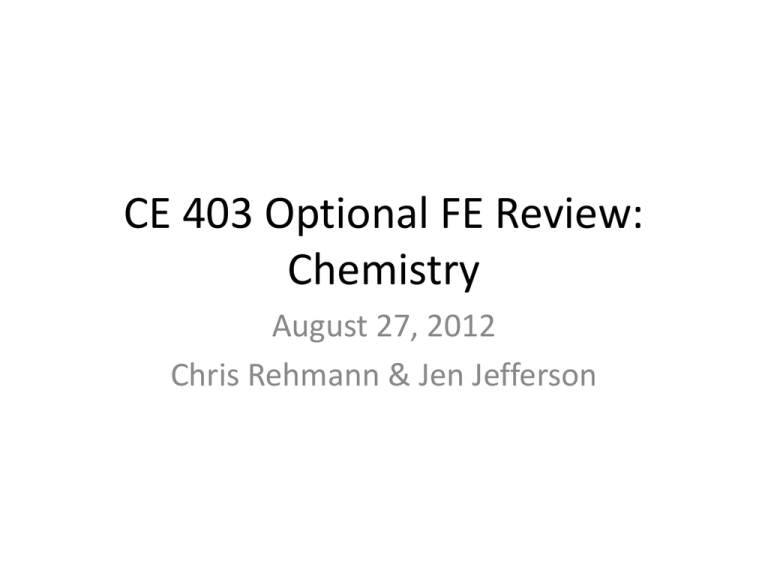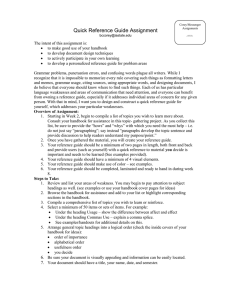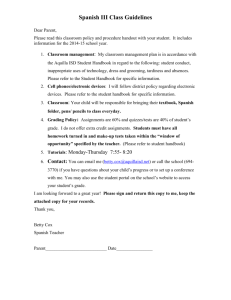CE 403 Optional FE Review: Chemistry August 27, 2012
advertisement

CE 403 Optional FE Review: Chemistry August 27, 2012 Chris Rehmann & Jen Jefferson Registering for the FE exam Note: EOL does offer a module on thermodynamics. Exam Preparation • Become familiar with NCEES supplied reference book http://www.ncees.org/Exams/Study_materials.php?exam=FE&product=1R • Study review books http://ppi2pass.com/shop/fe-eit-exam/fe-eit-exam-review-materials • Bird by bird • Take the exam seriously Strategies for Taking FE Exam • Pay attention to the time – Don’t wait until the end to transfer answers to the answer sheet – Don’t spend too long on problems that you can’t figure out • Attack the areas you know best, first • Save difficult problems for last • Think before you start writing – Is there an easy way to solve? – Are any answers obviously wrong? – Work backwards? • Answer EVERY question – Make a guess before moving on to the next question – Mark questions that you need to come back to Chemistry Approximate Percentage of Test Content = 9% • • • • • • • • Nomenclature Oxidation and Reduction Periodic Table States of Matter Acids and Bases Equations (e.g. stoichiometry) Equilibrium Metals and Nonmetals Reference Handbook: Page 100 Reference Handbook: Page 101 Reference Handbook: Page 102 Reference Handbook: Page 103 Barron’s 2nd ed. Example 3.1 235 92 U +6 Determine the: (A) Atomic number (B) Number of protons (C) Number of neutrons (D) Charge (E) Cation or anion? (F) Number of electrons (G) What number changes if the element is an isotope? Reference Handbook: Page 101 Group/Family 0 +1 +3 -/+4 -3 Symbol/Notation: -2 -1 Mass Number Atomic Number X Elements to left = metals Elements to right = nonmentals Charge/Oxidation State/Valence Noble Gases Semi-Metal Line Halogens = Number of Protons Transition Metals Alkaline-Earth Metals Period Alkali Metals +2 Barron’s 2nd ed. Practice Problem 2 Each species - + +2 Cl Ar K Ca has the same number of (A)protons (B)electrons (C)neutrons (D)isotopes Reference Handbook: Page 101 Newnan 14th ed. Problem 14-6 The formula for potassium aluminum sulfate (not including the water of hydration): (A) KAlSO4 (B) KAl(SO4)2 (C) K2AlSO4 (D) KAl(SO4)3 Reference Handbook: Page 101 Barron’s 2nd ed. Practice Problem 3 The correct chemical formula for chromium (III) oxide is: (A) CrO (B) Cr3O2 (C) Cr2O3 (D) Cr3O3 Reference Handbook: Page 101 Newnan 14th ed. Problem 14-10 The oxidation state of chromium in (NH4)2Cr2O7 is: (A) +5 (B) +6 (C) +7 (D) +8 Reference Handbook: Page 101 Barron’s 2nd ed. Example 3.7 A fix quantity of gas occupies a volume of 2.0 L at a temperature of 20°C and a pressure of 1.0 atm. The volume this gas would occupy at 40°C and 1.75 atm pressure is (A) 0.95 L (B) 1.22 L (C) 1.47 L (D) 2.31 L Reference Handbook: Page 19, 20, 73 USF Chemistry Question 3 This example and others are taken from http://fe.eng.usf.edu/ USF Chemistry Question 2 This example and others are taken from http://fe.eng.usf.edu/ Reference Handbook: Page 101 Barron’s 2nd ed. Example 3.9 Balance the following equation: _C4H10(g) + _O2(g) → _CO2(g) + _H2O(g) What is the mass of carbon dioxide that can be produced from 816 grams of butane, assuming oxygen is in abundant or unlimited supply? (A) 1,768 g (B) 2,200 g (C) 2,476 g (D) 2,229 g Reference Handbook: Page 101 Barron’s 2nd ed. Practice Problem 15 3Cu + 8HNO3 → Cu(NO3)2 + 2NO +4H2O (A)Is the following equation correctly balanced? (B) Which element is oxidized? (C) Which element is reduced? Reference Handbook: Page 100 Barron’s 2nd ed. Example 3.46 Consider the electrochemical cell with the following reaction: Mg(s) + Sn2+(aq)→ Mg2+(aq) + Sn(s) (A) What are the two half-reactions with their respective E° values? (B) Compute Enet°. (C) Does the reaction occur spontaneously? (D) Which species is oxidized and which is reduced? (E) Identify the anode and the cathode. Reference Handbook: Page 100, 103 Newnan 14th ed. Problem 14-43 What is the molarity of a solution prepared by dissolving 15.0 g of La(NO3)4 in 800mL of water? (A) 0.093 M (B) 0.031 M (C) 0.048 M (D) 0.039 M The following problems are from Newnan (1997), Engineer-in-Training License Review. Reference Handbook: Page 100 ‘gram moles’ is same as saying ‘moles’ Newnan 14th ed. Problem 14-40 The reaction below is carried out in a 5.00 L reaction vessel at 600 °K. CO(g) + H2O(g) = CO2(g) + H2(g) At equilibrium it is found that 0.020 mol CO, 0.0215 mol H2O, 0.070 mol CO2 and 2 mol H2 are present. Evaluate Keq for this reaction. (A) (B) (C) (D) 65.1 0.00307 236 326 The following problems are from Newnan (1997), Engineer-in-Training License Review. Reference Handbook: Page 100 Barron’s 2nd ed. Example 3.19 Find, for a 0.014 M solution of slaked lime, Ca(OH)2: (A) [OH-] (B) pH Reference Handbook: Page 100 Barron’s 2nd ed. Example 3.31 Consider the following reaction already at equilibrium. CS2(g) + 3Cl2(g) ↔ S2Cl2(g) + CCl4(g) ∆H°=-84.3 Predict what will happen – increase, decrease, or no change – to the equilibrium concentration of CCl4 when each of the following stresses is imposed: (A) Cl2 is added. (B) S2Cl2 is removed. (C) The temperature is increased. (D) The volume of the reaction vessel is decreased. (E) The pressure is decreased by increasing the reaction vessel volume. (F) A catalyst is added. Organic Chemistry Names Functional Group 1 – meth 2 – eth 3 – prop 4 – but 5 – pent 6 – hex 7 – hept 8 – oct 9 – non 10 – dec Remember: Carbon always wants 4 bonds !! Newnan 14th ed. problem 14-53 Name the type of compound shown by structural formula: O CH3 – CH2 – OH CH3C – O – CH3 CH3 – C – N (A) aldehyde (B) alcohol (C) organic acid (D) ketone (A) ester (B) aldehyde (C) organic acid (D) glycol (A) aldehyde (B) alcohol (C) organic acid (D) ketone The following problems are from Newnan (1997), Engineer-in-Training License Review. Electron Orbitals What element has the electronic configuration 1s22s22p4? What is the electronic configuration of Cr?






